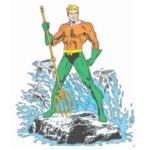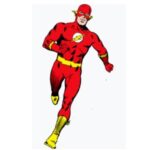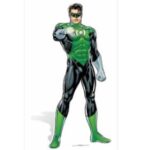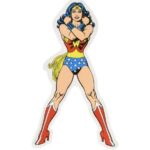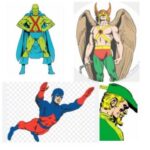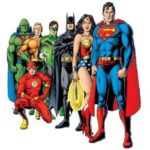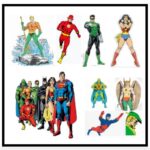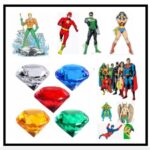Clicking on the following links or images will take you to the various DC super-hero comic collections covered in this section:
This section includes the comics featuring DC super-heroes other than Superman and Batman, who are covered in their own sections. DC has a long history of super-hero comics going back to the beginning of the Golden Age (late 1930s), and most of them are still around today. Below is a summary of many of these super-heroes.
Aquaman and Wonder Woman were two of the earliest super-heroes to be introduced during the Golden Age who has remained essentially unchanged since his debut. Other super-heroes like The Flash and Green Lantern made their debut around the same time but were completely reinvented during the Silver Age. These super-heroes have been published almost continuously for over eight decades since their introduction and are among the best known comic-book characters in the world. Along with Superman and Batman (and the lesser-known Martian Manhunter), they are the founding members of the Justice League of America (JLA), which was introduced in 1960.
Aquaman made his debut in More Fun Comics #73 in the early part of the Golden Age. After stints in various other titles including Adventure and Detective, Aquaman finally got his own comic-book title in 1962. Since then, like other DC super-heroes, Aquaman has gone through many versions as comic-books progressed through the Silver Age, the Bronze Age and the Modern Age.
The Flash was one of several DC super-heroes who made their debut in the Golden Age but were reinvented at the beginning of the Silver Age. The key person responsible for the reinvention of the Flash as well as several other Golden-Age superheroes (Green Lantern, Hawkman and the Atom) in the mid-1950s was editor Julius Schwartz, the man who was also responsible for two successful Batman reboots in the 1960s. The Silver-Age Flash (Barry Allen) lasted for three decades, until he was supplanted in 1987 by Wally West, who had appeared as the Kid Flash when younger in many Silver-Age Flash comics. This version lasted for a couple of decades, before giving way to other versions. Eventually, the wheel came full circle in 2009 and Barry Allen returned as the Flash in the 5-issue comic series Flash: Rebirth.
Green Lantern was introduced in the Golden Age but he was not particularly successful and faded away in the late 1940s. He was reinvented shortly after the Flash in the Silver Age. The Silver-Age Green Lantern (Hal Jordan) lasted for nearly four decades, going through various evolutions but basically retaining his essential identity. Then there were several others who took on the mantle of Green Lantern, but none of them could hold a candle to the original (Hal Jordan). Not surprisingly, DC eventually brought back Hal Jordan in the 2004 series Green Lantern: Rebirth. For me, there will always be one and only one Green Lantern: Hal Jordan. For this reason, I have not included comics featuring any alternative Green Lanterns in my list (other than the stories where they are supporting characters).
Wonder Woman made her debut in All Star Comics #8 in the early Golden Age. She was created by William Moulton Marston, writing under the pen name Charles Moulton. Since then, like other DC super-heroes, Wonder Woman has gone through many versions as comic-books progressed through the various ages, including an unfortunate detour in her career in 1969, when some misguided editors and writers at DC decided to take away her super-powers. Thankfully, the DC folks quickly came to their senses and Wonder Woman’s super-powers were restored within a few years. In 1987, the legendary artist (and writer) George Pérez did another reboot of Wonder Woman, taking her back to her original mythological roots. This rendering of Wonder Woman was a critical and commercial success, and the character has remained essentially unchanged since then.
The idea of banding together many of DC’s popular super-heroes together took shape in the early Golden Age, in the form of the Justice Society of America (JSA). Creating such a combined team of super-heroes was a truly pioneering concept, and it was highly popular. The JSA became the forerunner of the Justice League of America (JLA) which made its debut two decades later, in The Brave and the Bold #28 (1960). The JLA launch was very successful and it soon had its own magazine. A major highlight of the JLA stories was the array of colorful villains such as Dr. Destiny, Dr. Light, Amos Fortune, Felix Faust and the Weapons Master.
Like the other DC super-heroes, the JLA progressed through the various DC eras, often with significant changes in its identity and membership. One of the most memorable series was architected by Grant Morrison, with the new title officially being called JLA instead of ‘Justice League of America’, and it re-assembled the original ‘Big Seven’ super-heroes back into one team (Superman, Batman, Wonder Woman, Flash, Green Lantern, Aquaman and the Martial Manhunter). The new JLA stories turned out to be immensely popular and returned the Justice League title to best-selling status.
DC’s lesser-known super-heroes have their own charm and their comics are well worth reading, so I have created a special section featuring these, along with several landmark graphic novels featuring multiple characters, as described below.
The Atom and Hawkman were both introduced in 1940 and were both revamped in the Silver Age under editor Julius Schwartz and writer Gardner Fox. The Atom was completely reinvented and the Silver-Age version is very different from his Golden-Age incarnation. The changes in Hawkman were more subtle, primarily in his origin and backstory. Green Arrow was introduced the following year. He has been one of DC’s most enduring characters and his essential features have not changed much in the 80+ years since he made his debut. Unlike the other super-heroes described in this section, Green Arrow’s character became much more interesting in the Bronze Age and beyond. In my mind, Green Arrow remains one of DC’s most compelling comic-book characters to this day.
One of DC’s most intriguing heroes Elongated Man made his debut in the early 1960s as a supporting character in Flash comics, but eventually he became a regular backup feature in Detective Comics. The Elongated Man was one of the first DC heroes to reveal his secret identity to the public, and he was also one of the first to get married. The mid-1960s saw the debut of the first junior super-hero team: the Teen Titans. Although it was a great concept for younger comic-book readers, the stories and art were mediocre, so the title was not very successful and did not last very long. However, the team was revived by writer Marv Wolfman and artist George Pérez in 1980 as the New Teen Titans. This reboot was highly successful and it made the New Teen Titans title the bestselling DC comic of its time.
In addition to rejuvenating the Teen Titans, George Pérez and Marv Wolfman were also the creators of the landmark 1985-1986 graphic novel Crisis on Infinite Earths, which revamped the entire universe of DC super-heroes in one fell swoop. This broad-based rebooting of super-hero continuity became a regular feature in subsequent decades: the most notable of these crossover storylines was Flashpoint (2011). Another comic-book phenomenon in the mid-1980s was the classic graphic novel Watchmen. The writing and art of the graphic novel (by Alan Moore and Dave Gibbons respectively) are truly stunning and make it a literary masterpiece. Along with Crisis on Infinite Earths, it was also one of the major comic-book milestones which marked the beginning of the Modern Age.

